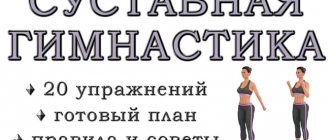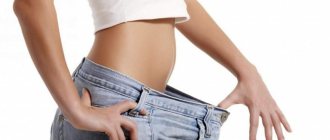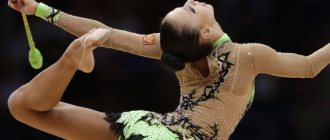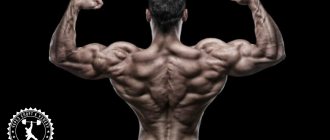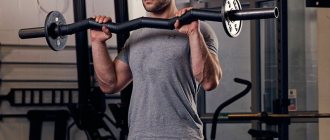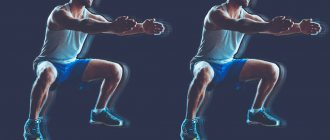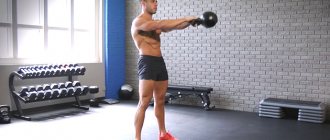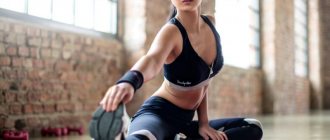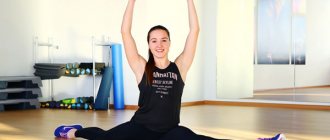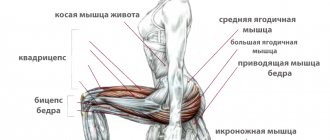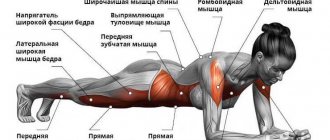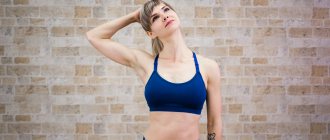Indications for the use of therapeutic exercises
Gymnastics in the treatment of scoliosis is indicated in the case of grades 1 and 2, as well as for the prevention of the disease in cases of diagnosed postural disorders. In this case, exercise therapy is the basis of treatment, and massage and physiotherapy are used as a supplement. In the third and fourth degrees of scoliosis, therapeutic exercises, like any physical exercise, should be used as an auxiliary method to the main treatment with extreme caution. In this case, physical activity is allowed only on the recommendation of a doctor. Exercise therapy is not a panacea for spinal diseases, and therefore sometimes turns out to be ineffective, despite doctors’ predictions. But in any case, a set of therapeutic exercises for scoliosis will bring the desired benefits if you do them regularly and follow the instructions exactly.
Video
This set of exercises must be performed at least once a day. In addition to this, it is necessary to include some other means of physical therapy in the rehabilitation course.
Editorial opinion
Physical therapy exercises have an undeniable benefit specifically on the spine, opening up tight sections and toning the muscles.
Classes using the Schroth method are very effective if the patient wears a corset. Schroth gymnastics is aimed at restoring the correct motor pattern and eliminating atrophic changes in the muscles. Gymnastics for scoliosis is aimed at straightening the back and relaxing, strengthening muscles. Blood circulation also improves and pain goes away. The correct selection of comprehensive classes is necessary.
Approximate set of exercises
Exercises for spinal scoliosis can be performed at home or in a specialist’s office. Strength training, sudden and aggressive movements are strictly prohibited - all exercises are performed at a calm pace, smoothly. Regardless of the program, the complex can be divided into several parts.
Warm-up exercises
Warm-up includes several types of exercises, each of which must be performed at least 5-10 times. For scoliosis, a warm-up allows you to warm up before the main back exercises. The following types of exercises are used:
- You need to press your back, heels, and gluteal muscles against a vertical surface (wall, cabinet), then take two steps forward. The position of the back should remain correct.
- From a standing position (arms along the body, feet shoulder-width apart), you need to squat and at the same time extend your arms forward. The back should remain straight.
- From a standing position, the leg bent at the knee should be raised as high as possible for a few seconds. Repeat the same with the other leg - your back should remain straight.
Basic exercises
This is the most important part in the complex of physical therapy exercises when correcting scoliosis. The basis of gymnastics are the following exercises:
- In a standing position (feet shoulder-width apart, arms along the body), you need to squeeze your shoulder blades for a few seconds, returning to the starting position.
- From the starting position on all fours (arms and legs shoulder-width apart), arch your back alternately up and down, holding for a few seconds.
- Lie on your stomach on a hard pillow, clasp your hands behind your back and begin to lift your body, holding this position for a few seconds.
Final part
Final exercises for scoliosis are necessary to restore breathing and heart rate:
- From the starting position, standing, holding your hands behind your back, walk on your heels for several minutes.
- From the starting position, standing, with your arms stretched forward, walk on your toes for several minutes.
- Raise your arms and at the same time take a deep breath, lower your arms and exhale at the same time.
For each patient, the doctor selects a set of exercise therapy exercises individually, depending on the form and degree of scoliosis. Patients are shown standard and asymmetrical exercises that help eliminate the pathological condition.
Prevention
Even in the absence of scoliosis, but with a sedentary lifestyle, it is recommended to observe prevention. There are no special exercise therapy exercises for prevention in this case; lifestyle plays an important role.
Prevention of scoliosis:
- playing sports (skiing, swimming, cycling, yoga), they develop flexibility, strengthen the back, contribute to the formation of a muscle corset, even a small morning warm-up and stretching shows effectiveness;
- maintaining correct posture , you should always stand with your shoulder blades straightened, move your shoulders away from your ears, and refrain from sitting cross-legged;
Pay attention to how to sit on a chair correctly
- when working sedentarily, it is recommended to take short breaks a couple of times an hour to warm up the lower back, legs and arms;
- You should sleep on a small pillow and a hard mattress ; it is recommended to ventilate the room before going to bed.
How long should you practice
How long it is necessary to do exercises and gymnastics to correct scoliosis depends on the stage of the disease, as well as the age of the patient. Exercise therapy only brings results with long-term sessions. When scoliosis is diagnosed in a child, it is very important to strictly follow the doctor’s recommendations, since the skeleton continues to form at an early age. In some cases, you have to make a set of therapeutic exercises for scoliosis part of your life - this is the only way to prevent the condition from worsening.
Diagnostics
It is not enough to simply see when examining a patient or his x-ray that the spine is curved. Moreover, at the early stage of the disease there will be no visible changes, and only a professional will notice the initial signs.
During diagnosis, the doctor determines a number of signs on which medical tactics and prognosis depend: - which part of the spine is curved; — from which vertebra the curvature began; - whether it is directed to the left or to the right; - does it have one arc or several; - which of the arcs was the first and many other signs.
Doctors at the Quality of Life clinic recommend examining your spine every 3 months if you or your child have been diagnosed with scoliosis. Timely diagnosis and correction will help you improve your posture and live a full life.
Let's consider the mandatory elements of high-quality diagnostics.
Survey
When communicating with the patient or his parents, the doctor finds out: - what complaints bother him (the presence of pain, asymmetry and other symptoms); - how long ago did they appear; - how quickly they progress; - what methods were used to treat the disease and what the effect was.
Perhaps the patient has diseases that can cause curvature, or his family members also have problems with the spine - all this is important for making the correct diagnosis and prescribing treatment measures.
Inspection
The doctor examines the entire musculoskeletal system, from head to toe, and performs special tests to look for signs of curvature.
Adams test - the patient leans forward, touching his hands to the floor and without bending his legs. This way you can determine the slightest asymmetry of the back.
During an external examination, the doctor can see: - asymmetrical shoulder blades, shoulder girdles, waist and pelvis; - deformed chest; - tilt of the torso to the side of the curvature.
Radiography
X-ray examination allows you to accurately determine the shape and location of the curvature, its severity, and also see changes in the structure of the vertebrae, intervertebral discs and the location of internal organs.
An X-ray of the spine is necessary to conduct important diagnostic tests, based on the results of which the doctor determines the severity of the disease:
— Determination of the Cobb angle or angle of curvature. The doctor finds the upper and lower vertebrae, between which the spine is curved. Draws perpendicular lines through them and at their intersection obtains the angle of the scoliotic arc. The magnitude of this angle is the severity of the curvature.
— Raimondi test to determine the rotation and torsion of the vertebrae. The doctor measures the vertebrae with a ruler and uses a special table to calculate the rotation index using these measurements.
— Additionally, an X-ray of the pelvis is prescribed to perform the Risser test. From the image, the doctor determines the degree of ossification of the pelvis (from to 5), and from it, judges how formed the spine and the skeleton as a whole are. Grade 5 according to Risser means that it is no longer growing. The degree of maturity of the spinal column directly affects medical recommendations and treatment prognosis.
The effectiveness of treatment is also monitored using x-rays.
Also, if necessary, the doctor can prescribe laboratory blood tests, kidney ultrasound, MRI, CT.
Contraindications for exercise therapy for scoliosis
Exercise therapy has contraindications, since the set of exercises exerts a certain load on scoliosis. In some cases, treatment has to be delayed:
- chronic diseases in the acute phase: require absolute rest until complete recovery;
- disturbances in the activity of the cardiovascular and respiratory systems of the body;
- pain during and after training;
- progressive curvature of the spine.
Exercise therapy in the treatment of scoliosis will give the expected effect only if the set of exercises was developed individually by a specialist. Choosing exercises on your own will not only not make your workouts effective, but can also make the situation worse.
The influence of sport on the musculoskeletal system
It is an undeniable fact that sport has a positive effect on the musculoskeletal system .
Muscle growth, so-called hypertrophy, is observed . In this case, the number of fibers remains unchanged, only the size of their cross-section increases. This occurs due to good blood supply to the tissues. An increased supply of oxygen to the muscles promotes the opening of a large number of small capillaries.
In addition, oxygen is utilized faster in trained muscles . The chemical composition of muscle mass also changes: the amount of glycgen and phosphogen increases. Thus, the muscles become stronger and more efficient.
With constant training, muscle hypertrophy occurs
As a result of regular exercise, cartilage, ligaments and tendons become stronger . The skeletal system also undergoes changes. The bones become more massive, the chest develops, and the spinal column strengthens. The cross section of the bone in athletes is wider than in those who do not play sports.
Physical education classes are of particular importance for the development of children and adolescents . A strong muscular system supports the spine and prevents it from curvature. In addition, sport helps strengthen the body's immune system. As a result, the child is less likely to “catch” an infection, which is one of the causes of scoliosis.
Also, strong back muscles protect the spine from injury, taking on part of the load. Therefore, physical education is mandatory for the prevention and treatment of scoliosis.
Study the structure of the back muscle corset: the lumbothoracic muscle is of particular importance for the spine
